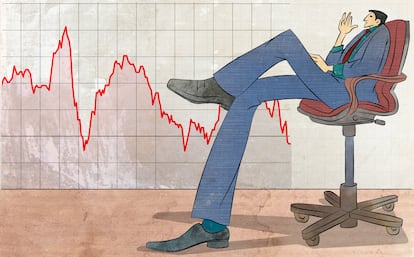The mysteries of inflation
The solution to disinflationary pressure is not to erect barriers to limit globalization and disintermediation

If the proverbial Martian came down to planet Earth and was given a graph of underlying inflation in the United States or the eurozone, the last thing that would occur to them is that the world economy had suffered the biggest financial crisis since the Great Depression and, a few years later, a global pandemic. From 2004 to March 2021, core inflation in the US and the eurozone has fluctuated in a narrow range of zero to 2.5%.
The stability of inflation has been impressive – remember the 1970-80s? The immediate reaction would be to applaud the success of monetary policy, which would have acted effectively to counteract the shocks that have affected the economy. In the same way that a thermostat manages the heating or air conditioning to keep constant the temperature of a house, whether it is cold or hot outside, monetary policy manages interest rates and asset purchases to keep inflation stable.
But it may not be that simple. Japan’s inflation has been excessively low since the mid-1990s, despite repeated attempts to increase it. Inflation in the eurozone has been stranded below target for two decades. The Fed has changed its monetary policy strategy precisely to avoid falling into the eurozone’s low inflation trap. The thermostat works, but it can be improved.
Raising barriers, such as trade tariffs or industrial policies that favor the purchase of domestic products, is counterproductive, except in very specific cases for geostrategic or national security reasons
The mysterious stability of inflation is a symmetrical phenomenon. There have been periods when inflation should have collapsed, such as during the financial crisis. The fall in economic activity in 2008 was much bigger than what economic models anticipated but, in comparison, inflation barely moved, breaking the relationship between activity and inflation that was observed before the crisis – and the same can be concluded during the coronavirus crisis. There have also been periods when inflation has risen less than you might have expected – for example, when unemployment in the US began to fall to levels not seen since the 1960s, and inflation barely budged. This is what has been called the “missing deflation.”
There are several possible solutions to the mystery. It is possible that, indeed, economic policy has become much more effective and credible, and that price stability has been achieved in the sense that US economist Alan Greenspan defined it: a situation in which citizens no longer care about inflation. If the objective of 2% is credible, all economic agents act under this hypothesis and all behaviors are adjusted almost automatically (wage negotiation, business planning, economic policy design, everything assumes 2% inflation) so that the objective is fulfilled. Returning to the example of the thermostat, the observed relationship between the external and internal temperatures disappears, since the thermostat adjusts as soon as the external temperature changes. It is an example of the so-called Goodhart Law, according to which when an economic relationship (for example, the relationship between unemployment and inflation) becomes a policy objective, the relationship is no longer observed in the data – precisely because economic policy acts in advance and neutralizes it.
The use of monetary policy instruments that go far beyond the ups and downs of interest rates – the detailed communication of central banks’ intentions, the purchases of both public and private assets, the provision of liquidity and even the active management of the parameters of financial regulation – have contributed in a fundamental way to the credibility of inflation targets. Imagine a world since 2007 without bond purchases or liquidity provision. The economic disaster, and the inflation collapse, would have been great. And now think about how much these actions were criticized at the time.
The credibility and ambition of monetary policy would explain the stability of inflation. But they are not enough to explain the downward bias of inflation in recent decades. Beyond the integration of China in the global economy, a fundamental cause has been the globalization and disintermediation of a growing part of economic activity, which increases competitive pressures and limits the ability to increase prices.
The credibility and ambition of monetary policy would explain the stability of inflation. But they are not enough to explain the downward bias of inflation in recent decades
Think, for example, of taxi services. Until a few years ago, it was a local service, managed by a licensing system that created barriers to entry and whose competition was the local metro, buses and trams. Suddenly a firm appears on the west coast of the United States that revolutionizes the technology of the provision of local transportation service. Suddenly a mobile application represents fierce competition to taxi services around the world. Now extend the example to the local distribution of consumer goods, banking, travel agencies, real estate and movies. Any activity that is susceptible to disintermediation through a mobile application faces potentially global competition. And this has generated a powerful and persistent disinflationary pressure that has surprised economic authorities. A posteriori, it looks like economic policy should have been more expansive.
The solution to this disinflationary pressure is not to erect barriers to limit globalization and disintermediation. After all, this is the process by which productivity and potential growth increase, which are the keys to economic wellbeing. But it must be considered when determining the rest of the economic policies. This disinflationary pressure leads to lower interest rates and therefore generates fiscal space to design policies, both of predistribution and redistribution, that compensate those affected by this globalization and disintermediation, alleviating the economic inequality that these generate. Raising barriers, such as trade tariffs – still in force in the US, let’s not forget – or industrial policies that favor the purchase of domestic products – such as the Made in America program announced by President Biden – is counterproductive, except in very specific cases for geostrategic or national security reasons.
The world economy is reopening, and the different speed of recovery of demand and supply is generating dislocations and, in some sectors, temporary increase in prices. This is not inflation – inflation is a sustained and broad increase in prices, which requires increases in nominal wages beyond the growth of inflation expectations, very unlikely with still very high unemployment rates. With inflation expectations well anchored, the time to control inflation will come once full employment has been secured. Or perhaps the mystery will persist, and inflation will continue on its path of stability.
Twitter: @angelubide
Tu suscripción se está usando en otro dispositivo
¿Quieres añadir otro usuario a tu suscripción?
Si continúas leyendo en este dispositivo, no se podrá leer en el otro.
FlechaTu suscripción se está usando en otro dispositivo y solo puedes acceder a EL PAÍS desde un dispositivo a la vez.
Si quieres compartir tu cuenta, cambia tu suscripción a la modalidad Premium, así podrás añadir otro usuario. Cada uno accederá con su propia cuenta de email, lo que os permitirá personalizar vuestra experiencia en EL PAÍS.
¿Tienes una suscripción de empresa? Accede aquí para contratar más cuentas.
En el caso de no saber quién está usando tu cuenta, te recomendamos cambiar tu contraseña aquí.
Si decides continuar compartiendo tu cuenta, este mensaje se mostrará en tu dispositivo y en el de la otra persona que está usando tu cuenta de forma indefinida, afectando a tu experiencia de lectura. Puedes consultar aquí los términos y condiciones de la suscripción digital.
More information
Archived In
Últimas noticias
Most viewed
- Reinhard Genzel, Nobel laureate in physics: ‘One-minute videos will never give you the truth’
- Oona Chaplin: ‘I told James Cameron that I was living in a treehouse and starting a permaculture project with a friend’
- Pablo Escobar’s hippos: A serious environmental problem, 40 years on
- Why we lost the habit of sleeping in two segments and how that changed our sense of time
- Chevy Chase, the beloved comedian who was a monster off camera: ‘Not everyone hated him, just the people who’ve worked with him’











































